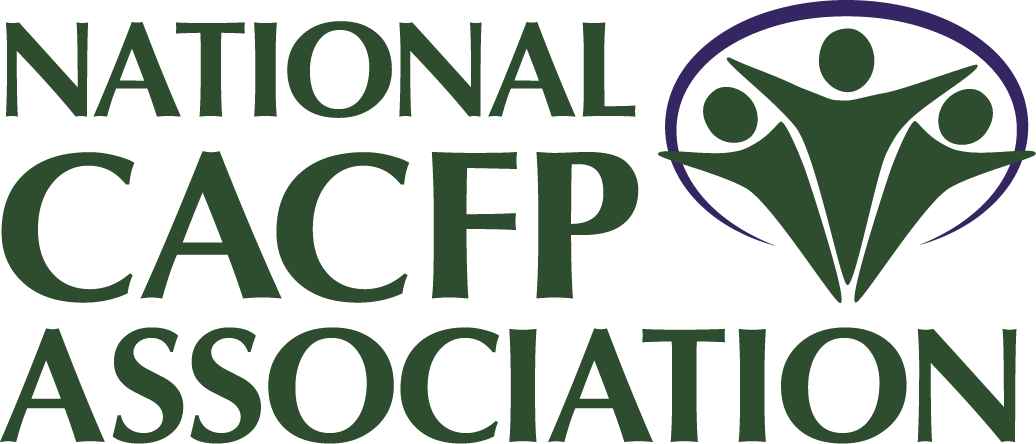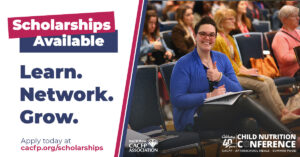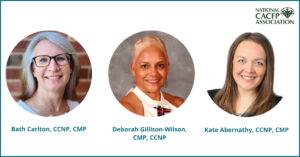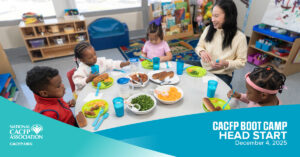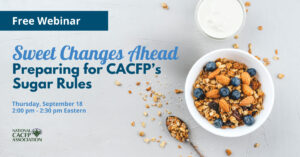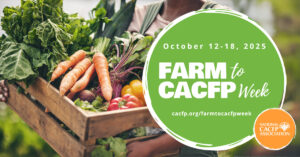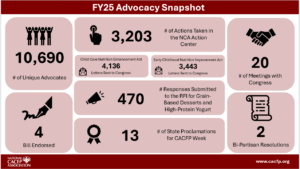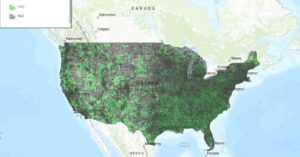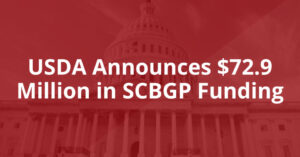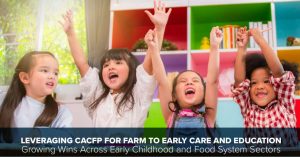Is raw cow’s milk creditable in the CACFP?
Read MoreThe National CACFP Association (NCA) is proud to continue its annual scholarship program for the 2026 National Child Nutrition Conference (NCNC), taking place April 13–17, 2026, in Las Vegas, Nevada.
Read MoreDoes mixing fresh fruits into yogurt count towards added sugars?
Read MoreThe National CACFP Association (NCA) Board of Directors has elected three members to serve on the organization’s Executive Committee. Deborah Gillison-Wilson, CMP, CCNP, was elected to a three-year term that consists of serving as the Chair-Elect for FY26, the Board Chair for FY27 and the Immediate Past Chair for FY28. Kate Abernathy, CMP, CCNP, has been elected Secretary and Beth Carlton, CMP, CCNP, was elected Treasurer, each serving two-year terms. Together, these leaders bring decades of experience, dedication, and advocacy to advance NCA’s mission of supporting the Child and Adult Care Food Program (CACFP) community nationwide.
Read MoreThe government shutdown has continued into November as Congress has yet to reach an agreement on Fiscal Year 2026 funding. We’ve put together a list of resources and ideas for providers to help families that experience disruption to food programs during the shutdown.
Read MoreJoin us for our CACFP Head Start Boot Camp on December 4th!
Read MoreThe National CACFP Association (NCA) is proud to continue its annual scholarship program for the 2026 National Child Nutrition Conference (NCNC), taking place April 13–17, 2026, in Las Vegas, Nevada.
Read MoreWe are closely monitoring the potential government shutdown on October 1 and its impact on the CACFP. As your trusted partner, we’ll keep you informed with timely updates.
Read MoreOver 2,000 key stakeholders and professionals from the Child and Adult Care Food Program (CACFP) and Summer Food Service Program community will convene for a week of nutrition education and professional development at the 40th annual National Child Nutrition Conference (NCNC) in Las Vegas, Nevada, from April 13–17, 2026.
Read MoreRegistration for NCNC26 is now open! Get ready for our 40th Anniversary – five days of training, networking and fun.
Read MoreBeginning October 1, 2025, the Child and Adult Care Food Program (CACFP) will implement new regulations requiring limits on added sugars in breakfast cereals and yogurts served in child and adult care settings.
Read MoreThis October marks the inaugural Farm to CACFP Week, hosted by the National CACFP Association to celebrate the benefits of connecting child and adult care programs with local foods.
Read MoreThe government shutdown has continued into November as Congress has yet to reach an agreement on Fiscal Year 2026 funding. We’ve put together a list of resources and ideas for providers to help families that experience disruption to food programs during the shutdown.
Read MoreWe are closely monitoring the potential government shutdown on October 1 and its impact on the CACFP. As your trusted partner, we’ll keep you informed with timely updates.
Read MoreCACFP advocacy is central to the mission of National CACFP Association (NCA) and NCA is continuously working to support and advocate for you! This year, we’ve worked to help raise awareness, expand and improve the CACFP. Your NCA membership supports these efforts. THANK YOU!
Read MoreIn the last few months, there have been many actions by USDA, HHS, and Congress impacting Child Nutrition Programs. Keep reading to see what you’ve missed and stay up to date with CACFP policy!
Read MoreSeptember 29, 2025 USDA announced that the CACFP and SFSP Area Eligibility Mapper has been updated for fiscal year 2026. Why It Matters Census data and school data are the two primary sources that may be used to determine whether a site is area eligible in CACFP and SFSP. Area eligibility is used to determine…
Read MoreUSDA announced $72.9 million in grant funding to states through the Specialty Crop Block Grant Program. The purpose of the SCBGP is to enhance the competitiveness of specialty crops, including fruits, vegetables, tree nuts, dried fruits, horticulture and nursery crops (including floriculture).
Read MoreExciting news! Head Start programs have an opportunity to access one-time supplemental funds to support nutrition services and healthy eating for enrolled children and families. You can use this funding for staff training on resources and educational opportunities to help your program improve outcomes for children and families and align with USDA requirements – like the CACFP!
Read MoreThe Child and Adult Care Food Program has new creditable foods listed on the USDA Food Buying Guide! If you are new to the FBG, this interactive tool allows for easy display, search, and navigation of food yield information. In addition, users can compare yield information, create a favorite foods list, and access tools, such as the Recipe Analysis Workbook (RAW) and the Product Formulation Statement Workbook.
Read MoreThe Child and Adult Care Food Program community asked for more Spanish resources to be available on the National CACFP Sponsors Association website and we heard you! Available now in Spanish are more resources to help sponsors and providers with meal pattern requirements, best practices, and so much more!
Read MoreServing meals to young people year-round benefits children, families, and care providers. To do this, many providers transition from operating the USDA Child and Adult Care Food Program (CACFP) At-Risk Afterschool (ARAS) during the school year to the Summer Food Service Program (SFSP) while school is out. For an overview of the main differences between SFSP and CACFP ARAS, see the comparison chart below.
Read MoreNCA understands that the end of flexibilities will cause challenges for many CACFP sponsors and providers and we commend your continued commitment to providing nutritious meals and snacks to the children or adults in your care. In preparation for the end of the additional reimbursement, we have collected the following resources to help you successfully provide meals even if your available budget decreases.
Read MoreIs raw cow’s milk creditable in the CACFP?
Read MoreDoes mixing fresh fruits into yogurt count towards added sugars?
Read MoreCan breakfast cereals ever be considered a grain-based dessert?
Read MoreHow does soy yogurt fit into the CACFP meal pattern?
Read MoreCan cow’s milk be purchased direcly from a farm and be creditablein the CACFP?
Read MoreAre peanut butter spreads creditable in the CACFP?
Read MoreExciting news! Head Start programs have an opportunity to access one-time supplemental funds to support nutrition services and healthy eating for enrolled children and families. You can use this funding for staff training on resources and educational opportunities to help your program improve outcomes for children and families and align with USDA requirements – like the CACFP!
Read MoreThe Child and Adult Care Food Program has new creditable foods listed on the USDA Food Buying Guide! If you are new to the FBG, this interactive tool allows for easy display, search, and navigation of food yield information. In addition, users can compare yield information, create a favorite foods list, and access tools, such as the Recipe Analysis Workbook (RAW) and the Product Formulation Statement Workbook.
Read MoreThe Child and Adult Care Food Program community asked for more Spanish resources to be available on the National CACFP Sponsors Association website and we heard you! Available now in Spanish are more resources to help sponsors and providers with meal pattern requirements, best practices, and so much more!
Read MoreServing meals to young people year-round benefits children, families, and care providers. To do this, many providers transition from operating the USDA Child and Adult Care Food Program (CACFP) At-Risk Afterschool (ARAS) during the school year to the Summer Food Service Program (SFSP) while school is out. For an overview of the main differences between SFSP and CACFP ARAS, see the comparison chart below.
Read MoreNCA understands that the end of flexibilities will cause challenges for many CACFP sponsors and providers and we commend your continued commitment to providing nutritious meals and snacks to the children or adults in your care. In preparation for the end of the additional reimbursement, we have collected the following resources to help you successfully provide meals even if your available budget decreases.
Read MoreAcross the nation, racial inequities have impacted access to federal nutrition programs for people of color. The report by D.C. Hunger Solutions aims to address how racial inequities contribute to hunger and poverty among residents of color in the District of Columbia and to lack of access to federal nutrition programs.
Read MoreWhen combined, the CACFP and Farm to Early Care Education (Farm to ECE) activities can have an extraordinary impact on children, child care providers, and local communities. FRAC’s report aims to support child care providers to access CACFP and utilize it for eligible Farm to ECE activities by highlighting the mutually beneficial synergy between these initiatives.
Read MoreThe CACFP is an indicator for state-level obesity prevention. The inclusion of the CACFP as an indicator for obesity-prevention shows that the CACFP is an important, recognized factor for proper development in the earliest stages of life.
Read MoreThe University of Colorado College of Nursing published their 2022 Annual Report on Achieving a State of Healthy Weight. The report determines how state regulations support obesity prevention in licensed ECE programs. It also highlights state successes and identifies opportunities for ECE regulations to improve support of obesity prevention in young children.
Read MoreA study was published in October 2023 by the Urban Institute to identify major gaps in the CACFP’s coverage and ability to reach children. The study specifically focused on CACFP eligibility for small home-based child care providers who are legally exempt from their state’s child care licensing requirements.
Read More